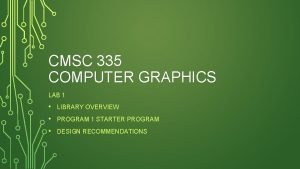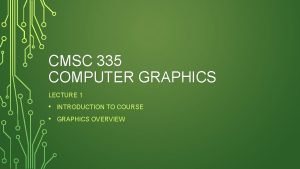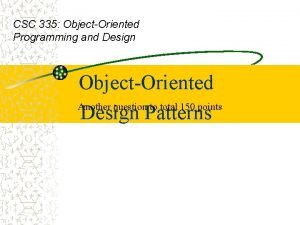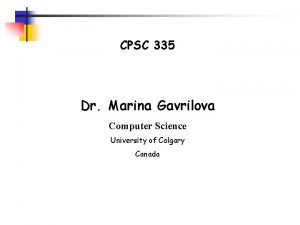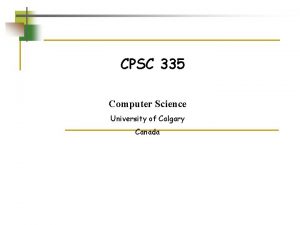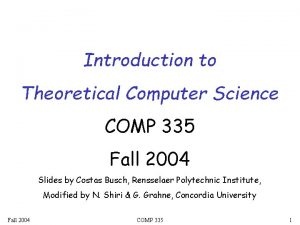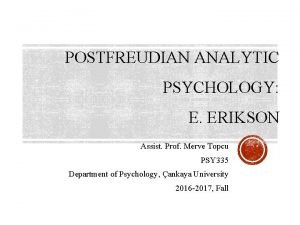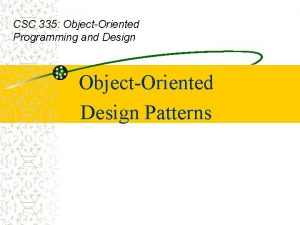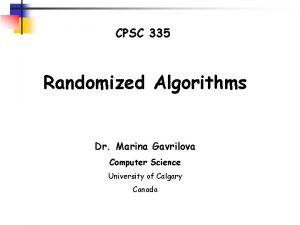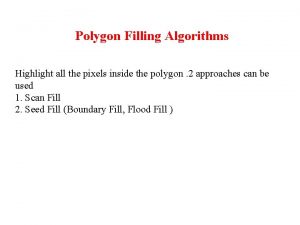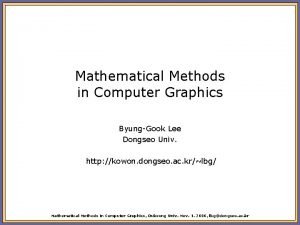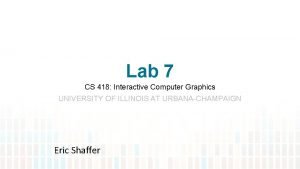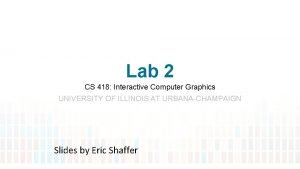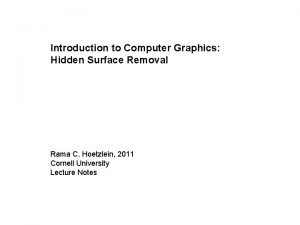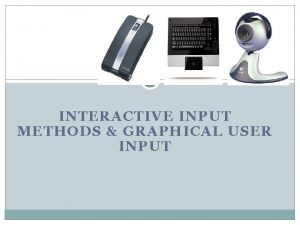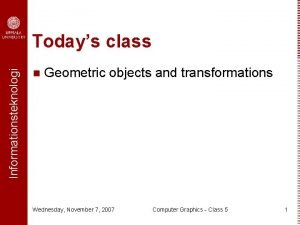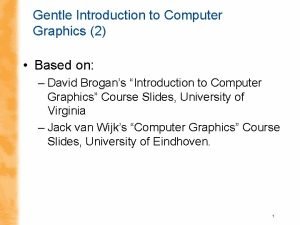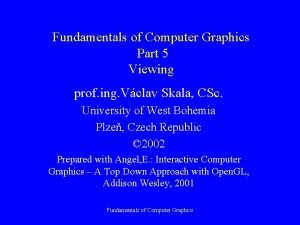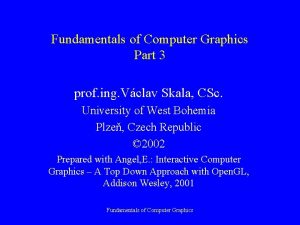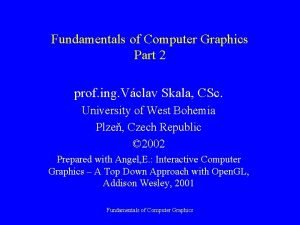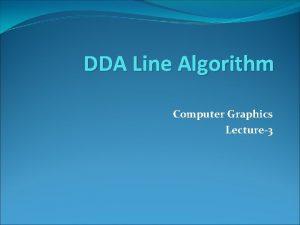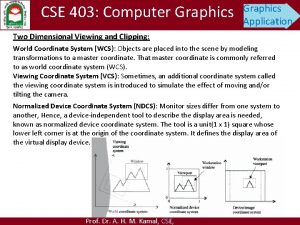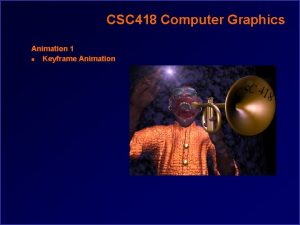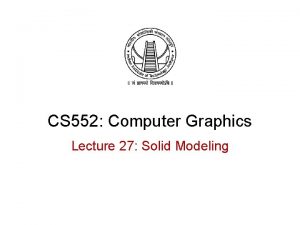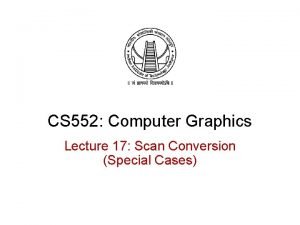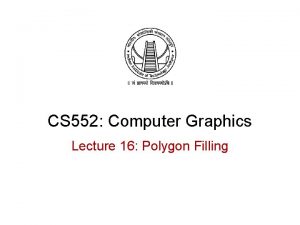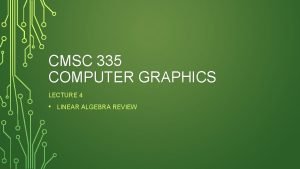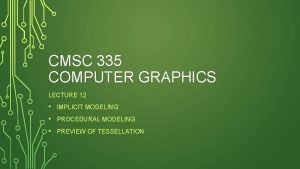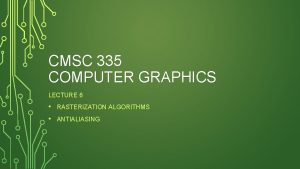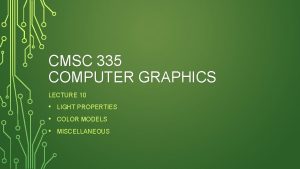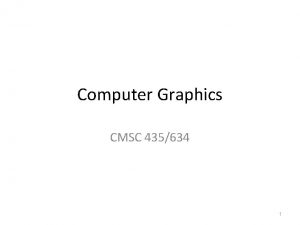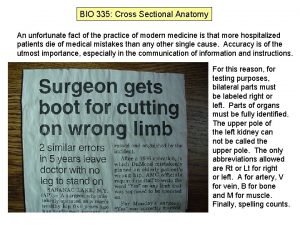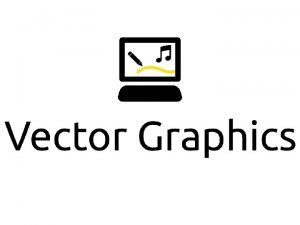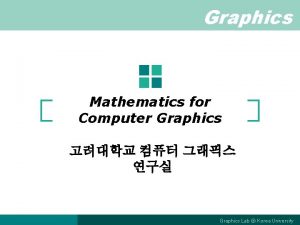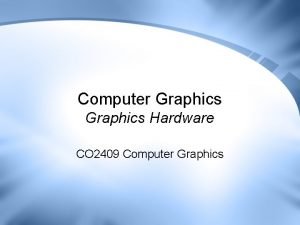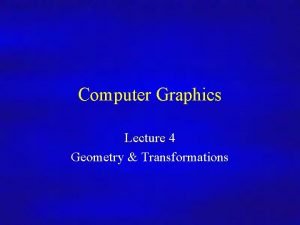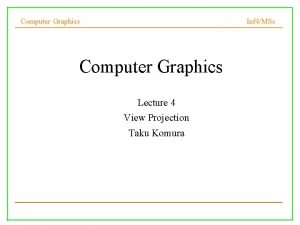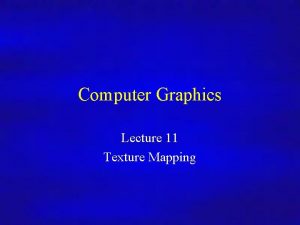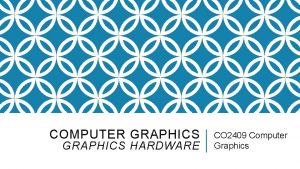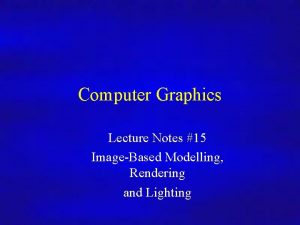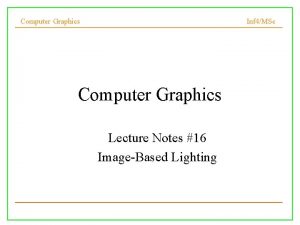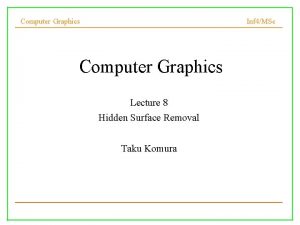CMSC 335 COMPUTER GRAPHICS LECTURE 6 2 D



















































- Slides: 51

CMSC 335 COMPUTER GRAPHICS LECTURE 6 • • 2 D TRANSFORMATIONS • VIEWING TRANSFORMATIONS 3 D TRANSFORMATIONS

BASIC GRAPHICS PIPELINE (VIEWING PIPELINE) y y y z x x z Projection Coordinates (Homogeneous) Device Coordinates x Model Coordinates z World Coordinates Camera Coordinates

2 D TRANSFORMATIONS

TRANSLATION FIRST LOOK • How would you apply this to a whole shape? What if shape is defined like a circle?

LINEAR TRANSFORMATIONS •

SCALING • How would you apply this to a whole shape? What if shape is defined like a circle?

SHEARING • Can be thought of as rotating one axis only. How would you apply this to a whole shape? What if shape is defined like a circle?

ROTATION •

ROTATION •

ROTATION • How would you apply this to a whole shape? What if shape is defined like a circle?

REFLECTION • Work with a partner • • Develop reflection transformations Consider how you would rotate an object about its center?

COMPOSING TRANSFORMATIONS •

COMPOSING TRANSFORMATIONS • This extrapolates to as many sequential operations as we want! • So we should compose a matrix of all of our transformations on an object first, and then apply it to an object. • Why? • • Does order matter? • • Argue with a comparison to a brute force algorithm and big-oh complexity. Determine a concrete example Can you compose all transformation types in this way? • Explain why/why not?

COMPOSING TRANSFORMATIONS •

FIXING TRANSLATIONS •

TRANSLATIONS WITH HOMOGENEOUS COORDINATES •

ADJUSTED SCALE • Synonymous Modification for Shearing/Reflection

ADJUSTED ROTATION •

HIERARCHICAL SYSTEMS • Consider the following: • • • A robot arm A dog walking A solar system • What is in common about animating them? • • All have many individual pieces Placement of the pieces depends on each other

HIERARCHICAL SYSTEMS • Z Y X W

3 D TRANSFORMATIONS

BASICS • Everything is synonymous • We will use a 4 D homogeneous coordinate so that translations can be represented as a linear transformation • • Rotations have 3 separate matrices (for now)… Linear transformations are composed the same and have the same ordering limitations • Create a composite matrix to apply to each point

TRANSLATION •

SCALING • Synonymous Modification for Shearing/Reflection

ROTATIONS •

A NOTE ON 3 D ROTATIONS •

TRANSFORMING NORMAL VECTORS • Applying transformations to all components of an object seems reasonable, but normal vectors are not straightforward • Consider a non-uniform scale, which would affect lighting They may no longer be normal to the surface!

TRANSFORMING NORMAL VECTORS •

INVERSE TRANSFORMATIONS •

COORDINATE TRANSFORMATIONS •

VIEWING TRANSFORMATIONS

VIEWING TRANSFORMATION • So far, our transformations have been between 3 D transformations in the world • We now need viewing transformations that map from 3 D to 2 D

RECALL OUR VIEWING TYPES • Parallel (Orthographic) • Parallel lines, stay parallel • Perspective • Parallel lines converge at vanishing points

y z VIEWING TRANSFORMATIONS x • Camera Transformation Projection Transformation Windowing Transformation

CAMERA TRANSFORMATION • • Side view Top view Iso view

CAMERA TRANSFORMATION • Translation Rotation Side view Top view Iso view

CAMERA TRANSFORMATION • Iso view

VIEWING PROJECTIONS • Orthographic view volume (Axis-aligned Box) Perspective view volume (Frustrum)

ORTHOGRAPHIC PROJECTION • Orthographic view volume (Axis-aligned Box) Scale Translation

ORTHOGRAPHIC PROJECTION • Easy method that returns the matrix • glm: : ortho(l, r, b, t, n, f) • Or • glm: : ortho(l, • a 2 Dish version… r, b, t) Orthographic view volume (Axis-aligned Box)

PERSPECTIVE PROJECTION • First the issue • We need a matrix multiplication that converts a frustrum into an axis-aligned box • Yikes! Perspective view volume (Frustrum)

PERSPECTIVE PROJECTION Viewing Plane • Side view

PERSPECTIVE PROJECTION •

PERSPECTIVE PROJECTION •

PERSPECTIVE PROJECTION • Viewing Plane Side view

PERSPECTIVE PROJECTION • Both perspective and symmetric perspective are easily acquired in glm • glm: : frustrum(l, r, b, t, n, f) • Generalized perspective • glm: : perspective(fovy, • Symmetric perspective aspect, n, f)

VIEWPORT TRANSFORMATION • • Translation Scale Windowing Transformation

VIEWPORT TRANSFORMATION • Easy method in gl for the viewport • gl. Viewport(x, y, width, height) • Note the slight difference in parameters from the viewing, i. e. , there is an offset here. Windowing Transformation

COMPOSING THE MATRICES •

ACTIVITY •

CONCLUSIONS • We can't get away from the math! • Properties give us faster algorithms and correct pictures • We have to reason about our appropriate coordinate frame • Always ensure sets of points/vectors are defined based on the same basis
 Cmsc335
Cmsc335 Cmsc 335
Cmsc 335 Most of the graphics monitors today operate as
Most of the graphics monitors today operate as Computer graphics introduction ppt
Computer graphics introduction ppt 01:640:244 lecture notes - lecture 15: plat, idah, farad
01:640:244 lecture notes - lecture 15: plat, idah, farad Csc 335
Csc 335 Cpsc 335
Cpsc 335 Cpsc 335
Cpsc 335 Djistrika
Djistrika 30 tac 335
30 tac 335 30 tac 335
30 tac 335 30 tac 335
30 tac 335 Sim 335
Sim 335 Psy 335 purdue
Psy 335 purdue Builder design pattern uml diagram
Builder design pattern uml diagram Cpsc 335
Cpsc 335 Computer security 161 cryptocurrency lecture
Computer security 161 cryptocurrency lecture Computer aided drug design lecture notes
Computer aided drug design lecture notes Computer architecture lecture notes
Computer architecture lecture notes Microarchitecture vs isa
Microarchitecture vs isa Angel
Angel Types of projection in computer graphics
Types of projection in computer graphics Display devices in computer graphics
Display devices in computer graphics In two dimensional viewing we have?
In two dimensional viewing we have? Shear transformation in computer graphics
Shear transformation in computer graphics Acos glsl
Acos glsl Difference between scan conversion of ellipse and circle
Difference between scan conversion of ellipse and circle Rigid body definition
Rigid body definition Boundary fill algorithm in computer graphics
Boundary fill algorithm in computer graphics Raster scan line in computer graphics
Raster scan line in computer graphics Polygon fill algorithm
Polygon fill algorithm Random vs raster scan
Random vs raster scan Computer graphics
Computer graphics Derivation of bresenham line drawing algorithm
Derivation of bresenham line drawing algorithm Cs 418 interactive computer graphics
Cs 418 interactive computer graphics Cs 418 interactive computer graphics
Cs 418 interactive computer graphics Hidden surface removal algorithm in computer graphics
Hidden surface removal algorithm in computer graphics Achromatic light in computer graphics
Achromatic light in computer graphics What are the interactive input methods? explain in detail.
What are the interactive input methods? explain in detail. Uniform scaling in computer graphics
Uniform scaling in computer graphics Uniform scaling in computer graphics
Uniform scaling in computer graphics Orthogonal projection in computer graphics
Orthogonal projection in computer graphics Logical input devices in computer graphics
Logical input devices in computer graphics Fundamentals of computer graphics
Fundamentals of computer graphics Polygon clipping in computer graphics ppt
Polygon clipping in computer graphics ppt Ellipse drawing algorithm in computer graphics ppt
Ellipse drawing algorithm in computer graphics ppt Dda computer graphics
Dda computer graphics What is window and viewport in computer graphics
What is window and viewport in computer graphics Keyframe animation in computer graphics
Keyframe animation in computer graphics Solid
Solid Scan conversion in computer graphics
Scan conversion in computer graphics 8 connected boundary fill algorithm
8 connected boundary fill algorithm
